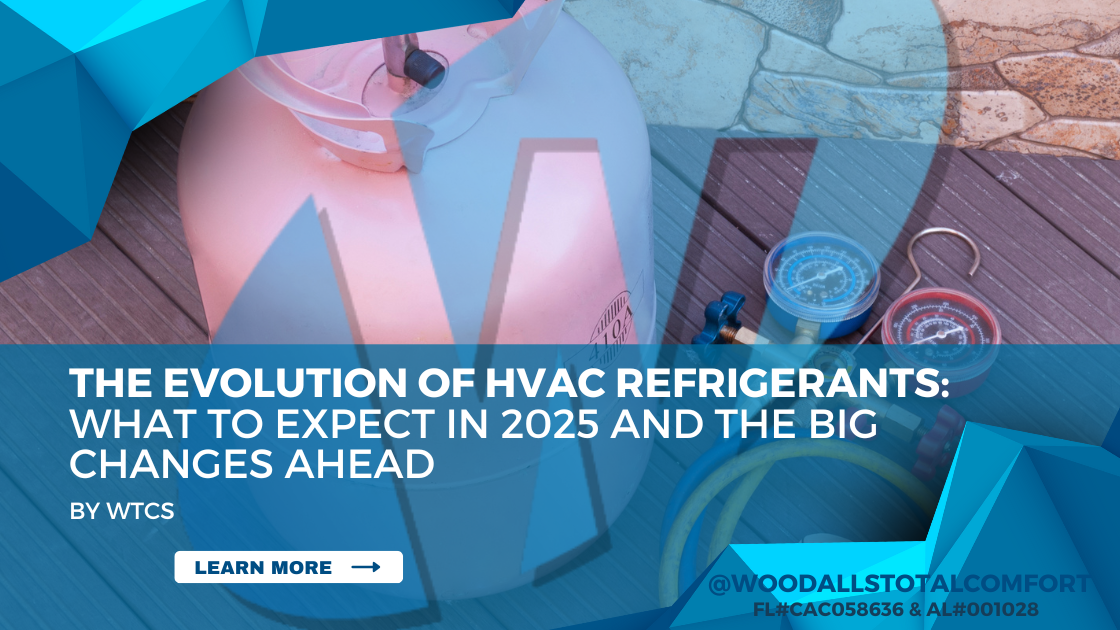The Evolution of HVAC Refrigerants: What to Expect in 2025 and the Big Changes Ahead
The HVAC industry has seen many changes over the years, especially regarding refrigerants. As we approach 2025, another major shift is happening that will impact homeowners and businesses alike. Let’s walk through the history of refrigerants to understand where we started, where we’re headed, and how these changes will affect you. We’ll also explain why choosing Woodall’s Total Comfort Systems is your best option for navigating this transition.
A Timeline of Refrigerant Evolution
- Pre-1990s: The Era of R-12 (Freon): R-12, commonly known as Freon, was the standard refrigerant for decades. It was highly effective, but over time, scientists discovered that it was severely damaging the ozone layer. This led to its phase-out under the Montreal Protocol, pushing the industry to seek alternatives (ACHR News & Environment Masters).
- 1990s-2010: The Introduction and Phase-Out of R-22: R-22 became the go-to replacement for R-12. It was less harmful to the ozone, but it still posed environmental risks. In 2010, the EPA began phasing out R-22 production and imports due to its high global warming potential (GWP), leading to a full ban on its production by 2020 (ACHR News & ACHR News).
- 2010-2025: The Reign of R-410A: To replace R-22, the industry adopted R-410A, a more energy-efficient refrigerant with a lower ozone impact. However, as environmental regulations tightened, the focus shifted toward reducing GWP even further. Though R-410A is better for the ozone, it still has a high GWP, making it a target for the next phase-out (Environment Masters & Environment Masters).
- 2025 and Beyond: The New Era of R-454B and R-32: Starting January 1, 2025, manufacturers will no longer produce HVAC systems using R-410A. Instead, the industry will transition to low-GWP refrigerants like R-454B and R-32. These new refrigerants are designed to reduce the environmental impact while maintaining efficiency and performance. However, they come with new considerations for safety and system design (ACHR News & Environment Masters & National Association of Home Builders).
What Does This Mean for You?
As a homeowner or business owner, these changes might sound overwhelming, but they don’t have to be. Here’s what you need to know:
- Your Existing System: If your current system uses R-410A, you can continue using it. Service and repairs will still be possible for years to come, but the cost of R-410A will gradually rise as production declines. Just as with the phase-out of R-22, we expect prices to climb due to limited availability (ACHR News & Environment Masters).
- New Installations: If you’re considering upgrading or replacing your system, now is the time to plan. The new refrigerants, R-454B and R-32, require updated equipment designed for their properties, such as slightly higher flammability. Working with a knowledgeable and experienced team like Woodall’s ensures a smooth transition with minimal disruptions (National Association of Home Builders & ACHR News).
Navigating the Transition: Why Choose Woodall’s?
At Woodall’s, our mission is to provide high-quality HVAC solutions with honesty and reliability. As this new era in refrigerants approaches, our commitment to these values remains unchanged. Here’s what sets us apart:
- Expert Knowledge: We stay ahead of industry trends, ensuring our technicians are fully trained on the latest refrigerants and safety protocols. We’re ready to handle the unique requirements of systems using R-454B and R-32.
- Customer-First Approach: We believe in providing straightforward advice. Whether you need to maintain your current system or explore new options, we focus on what’s best for you, not what’s most profitable for us. Our goal is to guide you through this transition with your comfort and budget in mind.
- Future-Proof Solutions: By planning early and upgrading to systems that meet the 2025 standards, you can avoid the price hikes and supply shortages that often come with regulatory changes. Woodall’s offers solutions that not only comply with the latest regulations but also optimize your system for long-term efficiency and performance.
What Should You Do Next?
- Evaluate Your Current System: If your HVAC system is older or nearing the end of its lifespan, now is the time to consider an upgrade. Newer systems using low-GWP refrigerants will be more efficient and environmentally friendly.
- Plan Ahead: Don’t wait until the last minute. As the 2025 deadline approaches, demand for compliant systems will rise. Acting now allows you to lock in better prices and avoid potential delays.
- Consult the Experts at Woodall’s: We’re here to answer all your questions and provide the best options tailored to your needs. From evaluating your current system to recommending the right upgrades, our team is dedicated to delivering top-notch service every step of the way.

The Woodall’s Difference: Trusted, Reliable, and Ready for the Future
As the HVAC industry undergoes this significant change, it’s crucial to work with a partner who not only understands the technical details but also values your comfort and satisfaction. At Woodall’s Total Comfort Systems, we pride ourselves on our integrity, expertise, and customer-focused service. Whether you need help understanding the new regulations or want to ensure your home stays comfortable and efficient, we’re here to make the process simple and stress-free.
Have more questions?
Check out our latest blog post where our Sales Team member Levi Cobb discusses when it might be the right time to replace your system! Read it Here!

